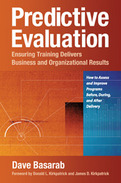Predictive Evaluation
Ensuring Training Delivers Business and Organizational Results
David Basarab (Author)
Publication date: 12/13/2010
Outlines a definitive process for determining the effectiveness and business impact of training.
-
Outlines a definitive process for determining the effectiveness and business impact of training
-
Works with any training program in any setting and at any stage of development
-
A how-to guide filled with worksheets, examples, and other tools
At last, an answer to the question that had bedeviled trainers for decades: how do you make the business case for training? Predictive evaluation enables you to effectively and accurately forecast training's value to your company, measure against these predictions, establish indicators to track your progress (and make midcourse corrections if needed), and report the results in a launguage that business executives respond to and understand. It's an approach that can be used for any sort of training program, in any setting, whether planned, newly implemented, or long established.
Dave Basarab explains how to begin by zeroing in on the program's intentions: what specific goals and beliefs do you want to instill in participants? The next step is to determine what these will look like when put into action -- what precise on-the-job actions and behaviors do you expect to see if these goals and beliefs are adopted? Finally, you develop quantifiable measures of how employees' adopting the target beliefs and goals will impact the business. In the end, all the information is pulled togethr into an Impact Matrix that provides a definitive picture of the program's intended and actual bottom-line results.
A key strength of predictive evaluation is that it is profoundly collaborative. Supervisors and employees work together to establish standards for success each step of the way. This guarantees the results will be relevant to the business and gives all participants a sense of ownership in the process.
Predictive evaluation will greatly enhance training's acceptance as a business function like any other, one where projections are made, progress is measured, and effectiveness is definitely determined. Rather than being regarded as an expense and an act of faith, training will be seen as an investment with a concrete payoff.
Find out more about our Bulk Buyer Program
- 10-49: 20% discount
- 50-99: 35% discount
- 100-999: 38% discount
- 1000-1999: 40% discount
- 2000+ Contact Leslie Davis ( ldavis@bkpub.com )
Outlines a definitive process for determining the effectiveness and business impact of training.
-
Outlines a definitive process for determining the effectiveness and business impact of training
-
Works with any training program in any setting and at any stage of development
-
A how-to guide filled with worksheets, examples, and other tools
At last, an answer to the question that had bedeviled trainers for decades: how do you make the business case for training? Predictive evaluation enables you to effectively and accurately forecast training's value to your company, measure against these predictions, establish indicators to track your progress (and make midcourse corrections if needed), and report the results in a launguage that business executives respond to and understand. It's an approach that can be used for any sort of training program, in any setting, whether planned, newly implemented, or long established.
Dave Basarab explains how to begin by zeroing in on the program's intentions: what specific goals and beliefs do you want to instill in participants? The next step is to determine what these will look like when put into action -- what precise on-the-job actions and behaviors do you expect to see if these goals and beliefs are adopted? Finally, you develop quantifiable measures of how employees' adopting the target beliefs and goals will impact the business. In the end, all the information is pulled togethr into an Impact Matrix that provides a definitive picture of the program's intended and actual bottom-line results.
A key strength of predictive evaluation is that it is profoundly collaborative. Supervisors and employees work together to establish standards for success each step of the way. This guarantees the results will be relevant to the business and gives all participants a sense of ownership in the process.
Predictive evaluation will greatly enhance training's acceptance as a business function like any other, one where projections are made, progress is measured, and effectiveness is definitely determined. Rather than being regarded as an expense and an act of faith, training will be seen as an investment with a concrete payoff.
"What is impressive is not only how Winters builds a case for the urgency and need for bold, inclusive conversations but ...
This practical, accessible, nonjudgmental handbook is the first to help individuals and organizations recognize and preve...
This book is the first practical, hands-on guide that shows how leaders can build psychological safety in their organizat...
"La’Wana Harris has opened this coach’s eyes to the power of coaching practices to create new paths for diversity and inc...








